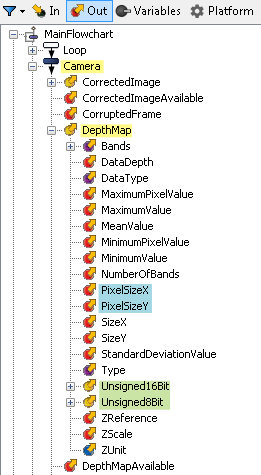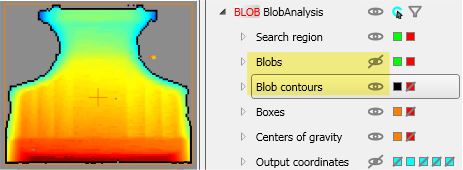You can access various depth map results from the
Camera step, including the depth map at different available
bit depths.
The following image shows the
Quick Evaluate pane and the available
Camera step outputs for a depth map. Double-click on an
output to see its current value.
Note that the Unsigned8Bit and
Unsigned16Bit
output images are available only if remapping is enabled for the
depth map (see the Remapping
subsection of the Procedure for using a depth
map section earlier in this chapter). When remapping is
enabled, you can link directly to these images, or you can select
the DepthMap
output image, which provides the version with the deepest suitable
bit depth for the step that links to the
Camera step. If remapping is disabled, the DepthMap image is an
unremapped version with a bit depth and data type provided by the
3D sensor. This version is usually not an image that can be used by
processing and analysis steps.
The PixelSizeX and PixelSizeY outputs indicate
the average world units per pixel. For uncalibrated images, the
value returned is 1.
You can calculate approximate volumes from a depth map, using
the SumOfPixels
output of the
BlobAnalysis step. The SumofPixels output returns
the sum of all pixel values in a blob. For a depth map, multiplying
this value by the X and Y pixel sizes gives the volume of the
designated depth map blob. Note that, for a correct volume
calculation, the reference position for depth values must be a
plane directly beneath the object(s).
Note that the depth map must be calibrated in X, Y, and Z.
To calculate the volume, apply the following:
-
Ensure that depth values are relative to the ground plane of the
scene, where Z = 0.
-
Add a
BlobAnalysis step to your project.
-
Adjust the settings in the
BlobAnalysis step's
Configuration pane to identify the required depth map
blob(s). Set the Image input to Camera.DepthMap and, on the
Advanced
settings page, set the Gray image mode input to
SourceImage. For
more information, see the
Gray image modes subsection of the
BlobAnalysis step advanced settings section in
Chapter 3: BlobAnalysis step.
-
Add SumOfPixels to the
Features section
of the
BlobAnalysis step's
Configuration pane.
-
Optionally, adjust the display to view the depth map and blobs
concurrently. To do so, select the
BlobAnalysis step, and then right-click on the step's
display view, and choose BlobAnalysis.Image from the
Display Image
dropdown list. Then, in the
Annotations control panel, make Blob contours visible, while
turning off the visibility of Blobs. This displays blobs
in outline form on the depth map. Adjust the color of Blob contours if
necessary.
-
Add a
Store step and set a variable to the result of the
following expression, which calculates the volume of the specified
blob:
BlobAnalysis.BlobFound(1).SumOfPixels*Camera.DepthMap.PixelSizeX*Camera.DepthMap.PixelSizeY
When entering the expression in the
Store step, note that you can drag and drop the BlobAnalysis.BlobFound(1).SumOfPixels result
from the blob occurrence's
Quick Watch flyout panel. Similarly, you can drag and drop
the Camera.DepthMap.PixelSizeX and
Camera.DepthMap.PixelSizeY
expressions from the
Quick Evaluate pane. Drop results and expressions into the
designated
Store step variable's Value to store input box,
while building the full expression.
For information on the
Store step, see the
Set variables with the Store step subsection of the
Procedure for adding and managing variables section in
Chapter 25: Variables and the Store step.
For an example of calculating a 3D volume from a depth map, see
the Volume from
depth map and defect detection example project.



